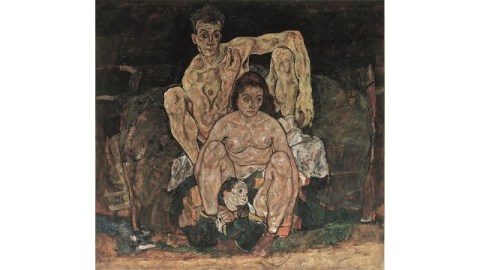How Prison Changed Egon Schiele’s Portraits for Better or Worse

“Bürgerschreck!”rang the accusations in German at Austrian painter Egon Schiele in April 1912. This “shocker of the bourgeois” found his home rifled by local constables searching for evidence of the immorality locals suspected of a man who lived with a woman not his wife and invited local children to pose for him. The constables brought over one hundred drawings as well as Schiele himself to the local jail, where he sat for 24 days until a court trial during which the judge flamboyantly burned one of Schiele’s “pornographic” portraits in front of the chastised artist before releasing him. That experience changed the rest of Schiele’s life and art. Egon Schiele: Portraits at the Neue Galerie in New York City centers on this turning point in Schiele’s portraits, which remain some of the most psychologically penetrating and sexual explicit portraits of the modern age. Schiele’s capacity to shock today’s audience may have declined as modern mores finally catch up to him, but the power of his portraits to captivate through their unconventionality, sensitivity, and empathy never gets old.
The first exhibition at an American museum exclusively focusing on Schiele’s portraiture, Egon Schiele: Portraits is curated by Dr. Alessandra Comini, who as a student in the 1960s not only used Schiele’s prison-time drawings to rediscover the cell where he was held, but also befriended Schiele’s surviving sisters and models to get closer to the man himself at that crucial moment when his freedom—both personal and artistic—was at stake. Drawing on the Neue Galerie’s Schiele collection, the finest collection in the United States, and loans from other institutions, the exhibition presents approximately 125 paintings, drawings, and even sculpture ranging from his earliest schoolboy exercises to the death mask taken of Schiele’s still-youthful, 28-year-old face upon his death during the Spanish Flu Pandemic of 1918, just three days after his pregnant wife Edith died from the same disease.
After the good, but conventionally academic portraits, Schiele’s sexually charged pictures simultaneously seem to come out of nowhere yet almost understandably come from the atmosphere surrounding the artist at that time. As Comini points out in her catalog essay, Schiele and fellow young artists such as Richard Gerstl and Oskar Kokoschka searched for a way to differentiate themselves from (and ultimately displace) the then-reigning king of portraiture, Gustav Klimt.
Whereas Klimt explored the erotic, Schiele and the next generation probed the psychological aspects of sex. “[U]nlike Klimt and his contemporaries,” Comini writes, Schiele et al. “were interested not in the beauteous, distracting façade, but, rather, in the quivering, fluid, intriguing psyche that lay underneath outer appearance.” Much of this sea change came about thanks to Sigmund Freud’s 1900 book The Interpretation of Dreams, whichwas, as Comini points out, “a book that few people actually read at the time but about which everyone had a pronounced opinion.” (Christian Bauer’s catalog essay “Paths to Expression in Egon Schiele’s Portraiture” fascinatingly adds pathology photographs of the mentally ill as well as police photos of criminals required to show both the face and hands together—a common Schiele motif—as additional influences on Schiele’s psychological portraiture.) Schiele voiced his opinion of Freud loudest in his shocking nude self-portraits, many painted using the full-length standing mirror Schiele kept near for his entire artistic life. “The nude self-portrait—exhibitionist and yet vulnerable—absorbed much of the artist’s painterly attention during the stylistically and thematically crucial years of 1910 and 1911,” Comini argues, stopping short of the crucial year 1912.
Did Schiele’s 1912 imprisonment have to happen? Diethard Leopold argues in the catalog that not only did it have to happen, but Schiele consciously or subconsciously wanted it to happen. “One could almost say that Schiele had begged for something like this to happen,” Leopold writes, “with the semi-conscious aim of breaking the stranglehold of his fixations and in the hope of being forced to mature as a man.” Schiele essentially scares himself straight into a different kind of portraiture post-imprisonment. “Before this hiatus [in jail],” Leopold continues, “we see self-expression taken to the extreme: idiosyncratic, mystical symbolism on the one hand and downright aggressive sexual motifs on the other.” Schiele himself inscribed on one of his prison drawings, “I do not feel punished, I feel cleansed.”
This cleansing, Leopold asserts, leads to “an improvement in both [Schiele’s] outward situation and of the subtle balances of the psyche… evident in his achievement of a more objective analysis and more contextual formulation of his inner tensions.” Before jail, Schiele paints the subject in the raw, physically and emotionally stripped to the point of searing agony. After jail, Leopold writes, “Schiele introduces distance between himself and his subject, so much so that, as time goes by, the former intensity fadesaway and a new kind of cautious, cooled-down realism takes over from hot and infectiousExpressionism.” Similarly, Comini sees a post-prison shift in Schiele from “a rebellious unmasking of his subjects’ ever-changing states of being, to a more empathic later approach that ironically reconciled the possibility of a centered soul with outward stress and vulnerability.” Remarkably, prison provides Schiele with an excuse to shed one persona he knew he couldn’t maintain forever for a new one he could envision over the long term.
Yet fate robbed Schiele of the long term, first with the disruption of World War I and the succession of deaths that robbed him of the family life—home, wife, child—he dreamed of someday having. Like that dream, Schiele’s painting The Family (Squatting Couple) (shown above) remained unfinished at his death. It collects in one single image all the contradicting aspects of Schiele’s pre- and post-prison career: frank male and female nudity, oddly balanced in a familial context; a sentimentalized, almost idealized child (a portrait of Schiele’s nephew Toni) surrounded by (perhaps) inappropriate sexuality; a strikingly honest celebration of the individual marked by an equally honest melancholia over how individuals, even children, end. Any reading of a Schiele portrait begins with biography, but Egon Schiele: Portraits takes biographical reading of these portraits to a whole new, eye-opening, heart-rending level.
“What would Schiele’s art have been like had he survived World War I and its rampant influenza aftermath?” Comini asks in the end. The whole of Egon Schiele: Portraits leads to that great “What if?” “We can surmise that his art would still have addressed the inner as well as the outer person,” Comini suggests. “But the artist’s portraits would likely have been more gentle, less reactive, more conciliatory, more painterly, and certainly more acceptable to the general public.” Would a kindler, gentler Schiele have been a better artist? Was Schiele ever meant to be comfortably embraced by the wider world? Would such a possible Schiele—happy husband, father, and artist—be as interesting a century later as the one we actually got? Egon Schiele: Portraits gives us an intimate portrait not only of the artist we thought we knew, but also of the artist that might have been.
[Image:Egon Schiele (1890-1918). The Family (Squatting Couple), 1918. Oil on canvas. Belvedere, Vienna.]
[Many thanks to the Neue Galerie, New York, for providing me with the image above from, a review copy of the catalog to, and other materials related to the exhibition Egon Schiele: Portraits, which runs through January 19, 2015.]





